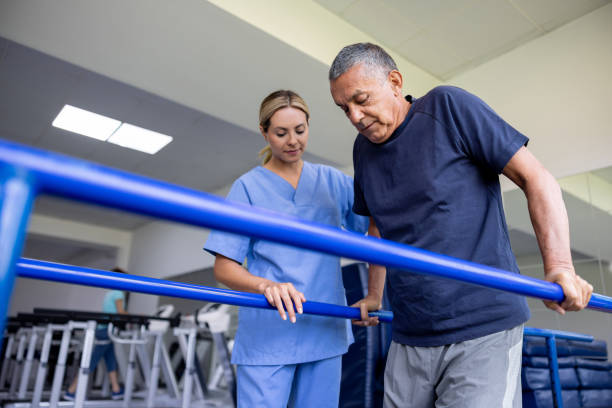
Latin American man doing physical therapy and walking on bars with the assistance of his physical therapist
Losing a limb is life-changing, but preparation can make a major difference in your recovery. If you’re facing amputation surgery, proper physical and emotional readiness before the procedure matters more than most people realize. The STRIDE program for amputation prep is a proactive approach that helps patients strengthen their bodies, build confidence, and prepare for a better post-operative experience.
What Is the STRIDE Program?
The STRIDE program is a pre-amputation physical therapy initiative designed to help patients prepare for life after surgery. STRIDE stands for “Strengthening, Training, and Rehabilitation in a Dynamic Environment.” The goal is simple: help you stay strong, mobile, and mentally ready.
Physical therapists and healthcare professionals work closely with patients to build custom exercise plans. These include strength training, stretching, and mobility exercises. The program also offers education, counseling, and emotional support—all essential parts of preparing for a major surgery.
Why the STRIDE Program for Amputation Prep Matters
The STRIDE program for amputation prep provides critical support before surgery. By getting your body in better shape, you reduce complications and shorten recovery time. It also helps you develop a clear understanding of what to expect, giving you greater control over your outcome.
Patients in the program often report feeling more confident and less anxious going into surgery. They also tend to have fewer post-surgical issues, such as joint stiffness, muscle loss, or mobility setbacks. The stronger your body before surgery, the smoother the road to recovery.
Who Should Join the STRIDE Program?
The STRIDE program is ideal for anyone scheduled for a planned amputation due to trauma, infection, diabetes, or other medical conditions. If you know that amputation is coming, starting therapy early gives you an edge.
This program is especially valuable for older adults, individuals with diabetes, or patients with limited activity levels. Pre-habilitation is not one-size-fits-all—it is adjusted based on your unique condition and needs.
Key Components of the STRIDE Program
1. Physical Therapy Exercises
Therapists focus on exercises that build muscle strength and joint flexibility. This improves blood flow and prepares the remaining limb and core muscles to adapt post-surgery.
2. Balance and Mobility Training
Balance is often affected after limb loss. STRIDE includes balance drills, walking practice (if applicable), and posture training to help your body adjust ahead of time.
3. Pain and Swelling Management
Techniques such as massage, compression, and targeted movements can reduce pain and control swelling before and after surgery.
4. Mental Preparation
Many patients experience anxiety before surgery. Mental health support and goal-setting are essential parts of the STRIDE process.
5. Education and Family Involvement
Patients and caregivers learn what to expect, how to manage daily tasks post-op, and how to make recovery more manageable at home.
Benefits of the STRIDE Program
Improved Surgical Outcomes
Patients are less likely to experience complications during and after surgery when they enter stronger and more mobile.
Faster Rehabilitation
The stronger you are before surgery, the faster your body recovers and adjusts afterward.
Better Emotional Readiness
Knowing what to expect helps reduce fear. You’ll feel more confident and positive about your future.
Improved Prosthetic Fit
Your muscles, joints, and skin will be in better condition to support a prosthetic limb after surgery.
Common Exercises in the STRIDE Program
Therapists usually focus on low-impact and targeted movements. These may include:
- Seated leg lifts
- Ankle pumps
- Gentle resistance training
- Arm strengthening with light weights
- Breathing exercises to build endurance
All exercises are supervised to ensure safety and effectiveness.
When Should You Start the STRIDE Program?
You should start the STRIDE program for amputation prep as soon as your doctor confirms surgery is needed. Ideally, this should be weeks before the scheduled date, giving your body enough time to build strength.
Early preparation can improve outcomes significantly. Don’t wait for symptoms to worsen or for surgery to get closer. The sooner you begin, the better the results.
Support Beyond Physical Health
What makes this program unique is that it doesn’t stop at exercises. The emotional toll of limb loss is often overlooked. STRIDE therapists provide:
- Counseling sessions
- Peer support groups
- Family education sessions
- Stress-reduction strategies
This complete approach ensures patients feel supported at every level—physically, emotionally, and mentally.
Is the STRIDE Program Covered by Insurance?
Most health insurance providers, including Medicare and Medicaid, recognize the value of pre-operative rehab. The STRIDE program for amputation prep is typically covered when prescribed by your doctor. Always check with your provider and ask your care team for help with documentation.
How to Enroll in the STRIDE Program
Talk to your doctor, surgeon, or case manager about enrolling. Hospitals and rehab centers offering amputation services often have STRIDE programs in place. Some locations even offer in-home or virtual sessions.
Make sure you receive a referral and schedule your first consultation quickly. Early enrollment helps maximize the benefits.
The STRIDE Program for Amputation: A Critical First Step
Starting the STRIDE program for preparation of amputation can help you regain strength, improve healing, and build confidence before surgery. By focusing on mobility, education, and mental preparation, it provides a complete support system when you need it most.
Conclusion
Preparing for amputation is challenging, but you don’t have to face it alone. The STRIDE program gives patients the tools they need to enter surgery stronger, more informed, and emotionally supported. With professional guidance and a customized plan, your recovery begins before the procedure ever starts. If you or a loved one are facing amputation, talk to your care team about joining the STRIDE program. It’s more than therapy—it’s a pathway to a stronger start after surgery.
Start your healing journey today with the Personalized Rehabilitation Support in Fort Myers, FL for amputation prep—gain strength, knowledge, and peace of mind before your surgery begins.
FAQs
- What does STRIDE stand for in the STRIDE program for amputation prep?
STRIDE means Strengthening, Training, and Rehabilitation in a Dynamic Environment. - How long does the STRIDE program usually last?
Programs typically run for several weeks before surgery, depending on your medical needs and schedule. - Can I do STRIDE exercises at home?
Yes, some exercises can be done at home under guidance. However, a therapist should always supervise your progress. - Is the STRIDE program only for lower limb amputations?
No. It benefits patients preparing for both upper and lower limb amputations. - Do I need a referral to join the STRIDE program?
Yes, a physician’s referral is usually required for insurance and program enrollment.



